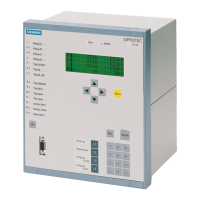Functions
2.9 Backup Time Overcurrent Protection
SIPROTEC, 7SD610, Manual
C53000-G1176-C145-6, Release date 02.2011
114
2.9.3 Setting Notes
General
During configuration of the scope of functions for the device (address 126) the available characteristics were
determined. Depending on the configuration and the order variant, only those parameters that apply to the se-
lected characteristics are accessible in the procedures described below.
Address 2601 is set according to the desired mode of operation of the overcurrent protection: Operating
Mode = ON means that the time overcurrent protection operates independently of the other protection functions,
i.e. as a backup time overcurrent protection. If it is intended to work only as an emergency function in case of
a transmission failure, set Only Emer. prot. Finally, it can also be set to OFF.
If not all stages are required, each individual stage can be deactivated by setting the pickup threshold to ∞. But
if you set only an associated time delay to ∞ this does not suppress the pickup signals but prevents the timers
from running.
The I>>> stage is effective even if the operating mode of the time overcurrent protection has been set to Only
Emer. prot and „>I-STUB ENABLE“ is released.
One or several stages can be set as instantaneous tripping stages when switching onto a fault. This is chosen
during the setting of the individual stages (see below). To avoid a spurious pick-up due to transient overcur-
rents, the delay SOTF Time DELAY (address 2602) can be set. Typically, the presetting of 0 s is correct. A
short delay can be useful in case of long cables for which high inrush currents can be expected, or for trans-
formers. This delay depends on the intensity and the duration of the transient overcurrents as well as on which
stages were selected for the fast switch onto fault clearance.
Directional Stages
The directional stages require additional settings.
At address 2603 Direct. 3I0, you set the measuring variables to be used for the direction determination of
the earth current stages.
If U0/I0 or U2/I0 has been set (default setting), negative sequence or zero-sequence values can be used.
Negative sequence system values are used if they are larger then the respective zero-sequence system
values. If the measuring variables of both systems are unavailable, the directional 3I0>stages are blocked.
If with U0/I0 has been set, the current zero-sequence values 3U
0
and 3I
0
are used. If the zero-sequence
voltage is too small for a direction measurement, the directional 3I0>stages are blocked.
If with U2/I2 has been set, the current negative sequence values 3U
2
and 3I
2
are used. If the negative se-
quence voltage is too small for a direction measurement, the directional 3I0>stages are blocked.
In addition, at address 2680 Direction Iph> or 2683 Direction 3I0>, set the pickup direction for the
directional stages I>ger and 3I0ger. The settings Non-Directional (presetting), Forward, and Reverse
are possible.
In address 2688 Direction IP or 2693 Direction 3I0P, you set the pickup direction for the directional
stages IPger and 3I0Pger. Settings Forward (default setting) and Reverse are possible.
